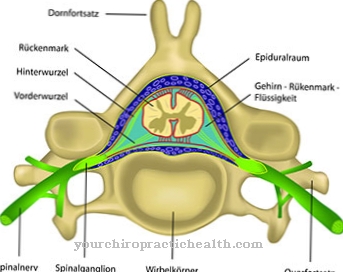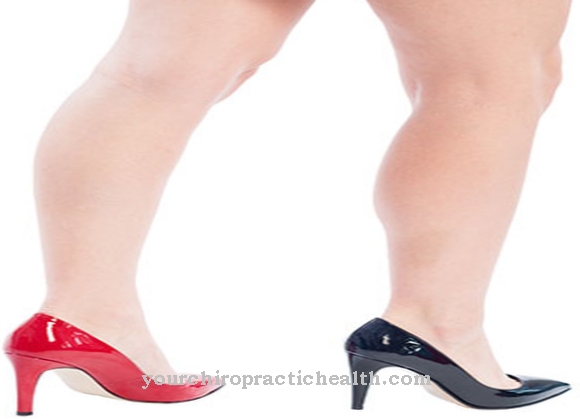The RAPADILINO syndrome is a malformation syndrome with the main symptoms short stature and skeletal malformation. The syndrome is based on a hereditary mutation. The treatment of the incurable disease takes place symptomatically.
What is RAPADILINO Syndrome?

© Aliaksandr Marko - stock.adobe.com
Some congenital malformation syndromes are predominantly associated with short stature. One of those syndromes is this RAOADILINO syndrome, whose name is acronymously composed of the typical symptoms. These include underdeveloped or missing forearm bones, underdeveloped kneecaps, malformations of the mouth and palate, diarrhea, displaced joints and short stature with deformed limbs.
The complex of symptoms was first described in 1989. The first person to describe it was a Finnish research group headed by Helena Kääriänen. The syndrome was described in more detail by researchers from the University of Helsinki and the University of Turku. In Finland, the prevalence is given by one person below 75,000. The syndrome is not limited to Finland, but is associated with documented cases in other countries.
The RAPADILINO syndrome is a hereditary disease apparently based on a genetic mutation. More precisely, the syndrome is caused by mutations in the RECQL4 gene. The gene takes on the coding for the so-called ATP-dependent DNA helicase Q4 in the DNA. This is an enzyme that breaks down twisted strands of DNA. Familial accumulation was observed in the cases documented so far. The syndrome seems most likely to be passed on as an autosomal recessive inheritance.
causes
The RECQL4 gene is involved in the replication and repair of DNA components. Various mutations in the gene can trigger the REPEDILINO syndrome. For example, nonsense mutations of exons 5, 18 and 19 have been described. These mutations generate a false stop codon and thus shorten the resulting protein, which results in a loss of function.
A frame deletion, which completely removes exon 7 from the protein structure during splicing, appears to be an even more common cause of disease. As a result, nearly 50 amino acids are missing. This frame mutation leaves the structure of the helicase coding intact. The fact that the helikinase malfunctions is probably due to incorrect protein folding due to the missing exon 7.
The cause of the incorrect folding is probably a shift in the isoelectric point or an increase in the polarity of the enzyme. The causal involvement of the helikinase in the symptom complex has meanwhile been established, but the exact connection with the individual symptoms remains the subject of speculation. Speculatively, the genetic cell stability sometimes depends on the mutated enzyme, making it susceptible to cancer, for example.
Since the enzyme was discovered in enterocytes, the malabsorption can also be explained and the diarrhea reproduced. The mutations of the gene described not only limit the helikinase activity, but also have a negative effect on the ability to cleave ATP.
Symptoms, ailments & signs
Newborns with RAPADIILINO syndrome suffer from a complex of different symptoms. The most characteristic of these are already hinted at in the name of the syndrome. RA stands for radial hypoplasia, which can go as far as aplasia of the radius. PA stands for hypoplasia of the patella, which can also correspond to a non-application.
The patient's palate is also strongly arched. The missing or underdeveloped kneecaps impair motor development. In addition, there is often a cleft lip and palate. DI stands for diarrhea and displaced joints in the name RAPADILINO syndrome. The joint displacement can manifest as a dislocation.
The LI abbreviates “little size” and “limb malformation”. So the patients are small in size and have malformed extremities. NO stands for "slender nose" and "normal intelligence". The mental development of the patient is normal. They are also equipped with an unusually slender nose. Apart from the eponymous symptoms, patients often suffer from malabsorption.
So you're not getting enough nutrients from food. In addition to the characteristic diarrhea, vomiting can also promote malnutrition and increase short stature. In some cases, those affected also showed dermal symptoms such as café-au-lait stains. In addition, the cancer risk of patients is increased by more than a third, especially the risk of osteosarcomas and lymphomas.
Diagnosis & course of disease
To diagnose the RAPADILINO syndrome, the doctor focuses on the characteristic symptoms. A molecular genetic analysis is possible, but mostly not necessary and often imprecise. In terms of differential diagnosis, the doctor must differentiate the RAPADILINO syndrome from other mutations in the RECQL4 gene. These include the clinically similar Rothmund-Thomson syndrome and Baller-Gerold syndrome.
The demarcation is often simple, since the first-mentioned syndrome is particularly impressive due to dermal changes. In the second syndrome, there are changes in the bony skull. In the case of RAPADILINO syndrome, differential diagnosis and confirmation of the diagnosis can usually be performed by means of imaging. The patient's prognosis depends on the severity of the syndrome in each individual case.
Complications
As a very rare, hereditary disease, the RAPADILINO syndrome mainly shows malformations in the area of the forearm bones, the kneecaps as well as in the mouth and palate area. The malabsorption observed especially in children often causes complications. Malabsorption is characterized by constant diarrhea and frequent vomiting due to a reduced utilization of nutrients.
This often leads to malnutrition in the affected children, which leads to failure to thrive and stunt. The short stature that occurs in RAPADILINO syndrome can be caused largely by malnutrition in addition to disorders in the skeletal system. Other problems can be caused by the displaced and constantly dislocated joints. The malformations in the joint system can be corrected surgically.
Sometimes prostheses have to be used. Malabsorption can also be treated well with medication. In severe cases, however, artificial nutrition is sometimes necessary in order to supply the body with sufficient nutrients again. The greatest danger, however, comes from the approximately 40 percent increased risk of cancer compared to the normal population. An increased incidence of lymphomas and osteosarcomas is observed.
Therefore, particular attention should be paid to changes in symptoms in patients with RAPADILINO syndrome. Increasing bone pain, frequent fractures, and worsening gait disorders are all warning signs of a possible osteosarcoma. In addition, regular examinations for the possible development of lymphomas should be carried out.
When should you go to the doctor?
RAPADILINO syndrome must always be treated by a doctor. Since this is a genetic disease, it cannot be treated causally, but only symptomatically. However, the person affected can also undergo genetic counseling so that the RAPADILINO syndrome is not passed on to the descendants. The RAPADILINO syndrome is usually diagnosed by the doctor before the birth or shortly after the birth.
Therefore, a visit to the doctor is not necessary to diagnose the syndrome. However, further treatment takes place through various surgical interventions that can alleviate the individual complaints. A doctor should be consulted if the child cannot be fed properly and this leads to malnutrition. Since the cancer risk is also significantly increased by the RAPADILINO syndrome, regular preventive examinations should be carried out in order to detect and treat tumors at an early stage. In some cases, therefore, the life expectancy of the patient is also reduced by the disease. The treatment itself takes place with various specialists.
Treatment & Therapy
Since the RAPADILINO syndrome is based on a genetic mutation, the complex of symptoms has so far been incurable. Only a gene therapy approach could eliminate the cause of the disease and thus cure the syndrome. Gene therapy approaches are the subject of research, but have not yet reached the clinical phase. Therefore the syndrome can only be treated symptomatically at the moment.
The therapy therefore depends on the symptoms in the individual case. The multiple malformations of the skeleton can be treated surgically reconstructively. The non-placement of the individual bones can also be compensated for by using prostheses. The treatment of disorders in the digestive tract is of particular relevance. This symptom must urgently be counteracted with medication in order to prevent a more severe nutritional deficiency.
If this has already occurred, direct administration of appropriate medication and substitutions is indicated. Physiotherapeutic measures can be useful to support the patient's motor development. Since patients with the syndrome do not have to expect any mental limitations, the early promotion of intelligence is not a necessary therapeutic step.
You can find your medication here
➔ Medicines for painprevention
The RAPADILINO syndrome can only be prevented by genetic counseling during family planning. Since the fine ultrasound also detects malformations during pregnancy, parents can decide against the child if necessary.
Aftercare
With RAPADILINO syndrome, follow-up care depends on the symptoms and the type of therapy. Following reconstructive surgery or the use of a prosthesis, it is essential to take the medication correctly. Doctors often recommend physiotherapy to improve the patient's motor skills.
The parents of the sick children are responsible for their support and should prepare well for it. On the one hand, it is about practical assistance in everyday life, on the other hand, it is about psychological support. The child needs some stimulation for physical activity. Such aftercare helps to gradually build muscle.
If the child is still bedridden, it must not be sore. Depending on the individual situation, the young patients need occupational therapy, and an outpatient care service may also be necessary. Children will cope better with the syndrome with comprehensive education about the disease. It is also helpful for the other family members to be open about it.
Since this is a hereditary disease, the specialists recommend genetic counseling as part of the pre- and post-operative care. This is used for family planning. Contact with other affected families also protects parents and other relatives from frustrating experiences.
You can do that yourself
Children who suffer from RAPADILINO syndrome must be treated with medication, surgery and physiotherapy. Parents of affected children can do something to support treatment.
In everyday life, aids such as walking aids or a wheelchair are available, which often only need to be used for a few weeks or months if the outcome is positive. In general, care should be taken to ensure that the child moves around sufficiently. In bedridden children, special attention should be paid to sores. The child needs sufficient activity and should ideally be looked after by an outpatient nursing service. In addition, the person affected must be informed about their illness at an early stage. An open approach makes dealing with the serious hereditary disease easier.
Regular contact with other people affected is just as important. The doctor can give tips for further measures with which the medical therapy of the RAPADILINO syndrome can be supported. Mothers who want to become pregnant again after having a child with RAPADILINO syndrome should seek genetic counseling. In addition, some measures must be taken before and during pregnancy, which are discussed in detail with a specialist in hereditary diseases.

.jpg)
.jpg)


.jpg)







.jpg)

.jpg)
.jpg)











.jpg)